|
OSTRACODE ASSEMBLAGES IN THE SOUTHERN GULF OF MEXICO: AN OVERVIEW
Trabajo recibido el 30 de junio de 1988 y aceptado para su
publicación el 14 de marzo de 1989.
Maria L. Machain-Castillo
Instituto de Ciencias
del Mar y Limnología, Universidad Nacional Autónoma de
México, Apartado Postal 04510, D. F. México. Contribución
No. 650 del Instituto de Ciencias del Mar y Limnología, UNAM. Trabajo
parcialmente presentado en la Reunión Anual (1987) de la Sociedad
Geológica de América.
Se estudian los
Ostrácodos Recientes del Golfo de México en el área
comprendida al sur del paralelo 210 norte, sus patrones de distribución
y los factores responsables de éstos. Por medio de un análisis de
factores de modo Q, se delinearon las áreas de distribución de
seis conjuntos de ostrácodos: dos en la zona central del golfo, a una
profundidad de más de 2000m, dominados por especies de
Krithe hasta en un 85%; uno en la zona occidental, de Tuxpan
hasta el oeste de la desembocadura del Río Grijalva, caracterizado por
una mezcla de especies batiales y de plataforma; y tres conjuntos en la
región de la Laguna de Términos, representando de este a oeste la
transición entre la plataforma carbonatada y la provincia
terrígena del sur del Golfo de México.
Distribution
patterns of Holocene Ostracoda from the Gulf of Mexico, south of latitude
21° North, were analyzed. The geographic range of six ostracode
assemblages was delineated by Q-Mode Factor Analysis. There are two Central
Gulf of Mexico faunas characterized by species ofKrithe; a
Western Gulf of Mexico assemblage from Tuxpan to the Grijalva River, comprising
a mixture of bathyal and shelf species; and three ostracode assemblages around
the Terminos Lagoon, reflecting the East-West transition between the Yucatan
carbonate platform and the terrigenous province of the Southern Gulf of Mexico.
This distribution of ostracodes seems to be influenced by changes in salinity,
depth and type of sediment.
Holocene Ostracoda in the noythern Gulf of Mexico are relatively well known, especially in marginal marine environments (see Maddocks, 1974, and Palacios-Fest et al, 1983 for reviews). However, they are practically unknown in the southern Gulf. The only published studies in Mexican waters are those of Sandberg, 1964; Morales, 1966; Krutak (1971,1974,1977,1982); Krutak and Rickles (1974), and Krutak et al (1980), for lagoonal and reefal environments. There are no published studies on open marine ostracodes. The present report is part of a long term micropaleontological research undertaken by the Micropaleontology Laboratory of the Marine Sciences Institute of the National Autonomous University of México. This project attempts to establish the characteristics and ecological relationships of the principal shelled microorganisms present in the sediments and contributes to the Quaternary history of the Southern Gulf of México. This paper gives an introduction to the marine Ostracoda of the Southern Gulf of Mexico, determines their distribution patterns, and discusses several environmental factors that affect this distribution. The most common species are illustrated. The systematics of the group will be presented in a subsequent paper. AREA OF STUDYThe study area is located in the southernmost portion of the Gulf of Mexico, between latitude 21º and 18ºN and longitude 91° and 97°W (Fig. 1). It represents a very interesting area from both scientific and enconomic points of view, because it comprises the transition between the Yucatan Platform and the Gulf of Mexico Gulf of Mexico provinces where much human activity such as fisheries and oil exploitation is carried out. It is also an area of environmental interest because industrial wastes are dumped in the rivers that discharge in the area. It is therefore important to undestand the characteristics and dynamics of the area, as well as the behavior of the biological populations that live there. 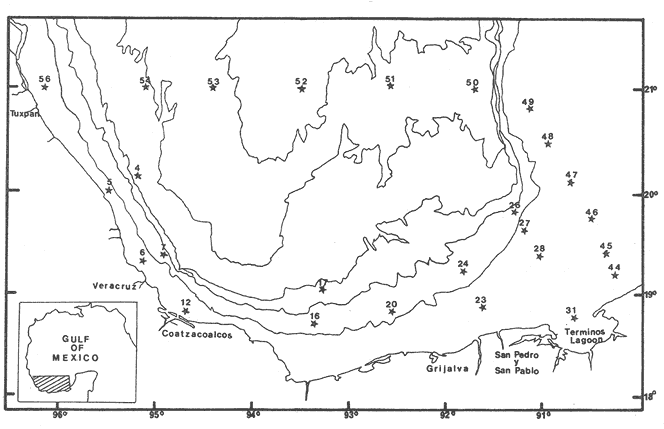 Figure 1. Location of area of study and sampling sites. OCEANOGRAPHIC SETTINGSThe general water circulation patterns have been outlined by Nowlin (1972). Surface temperatures in the area do not show major changes (Greiner, 1974). Bottom temperatures vary greatly with depth and during the time of collection they ranged from 24.9ºC in the shallowest sample to 4.7ºC at aproximately 1000 m (Table 1). The salinity distribution pattern is influenced by the discharge of the main rivers in the area (Fig. 1) and by a high salinity (over 36.5 ‰), water mass located on the Campeche Bank (Lizarraga-Partidaet al, 1984), and between the Terminos Lagoon and the Grijalva River (Padilla et al, 1987) (Fig. 2). According to Padilla et al (1987), the typical salinity profile of the Campeche Bay east of the Terminos Lagoon, shows values over 36 ‰ in a well mixed water column with horizontal changes of the order of 0.1 ‰. To the west or Terminos Lagoon, the dense high salinity (over 37 ‰) superficial waters sink to 75 m. This salinity maximum can be traced to about longitude 93ºW and then disappears. 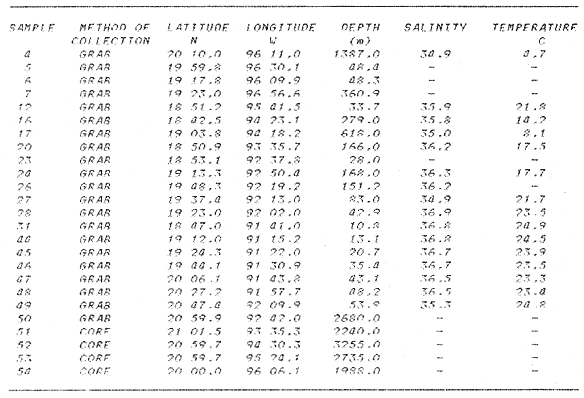 TABLE 1 LOCATION AND PHYSICAL PARAMETERS OF THE SAMPLES COLLECTED.(AFTER IMECO CRUISE MEMBERS) The sediments in the Campeche Bay Shelf grade from carbonate sand and mud to siliciclastic sand and mud from east to west (Lecuanda and Ramos, 1985) (Fig. 3), forming a transition zone seaward of Terminos Lagoon where sediments range from less than 25 to over 50% carbonate. This transition represents well the overall conditions of the area that marks a major shifting boundary in the distribution of many groups of oganisms. To the east waters are clear, with carbonate sediments and low organic matter content. Benthic vegetation is well developed. To the west, waters are more turbid, with high organic matter content, terrigenous sediments, and no sea grass (YañezArancibia and Sánchez-Gil, 1986). 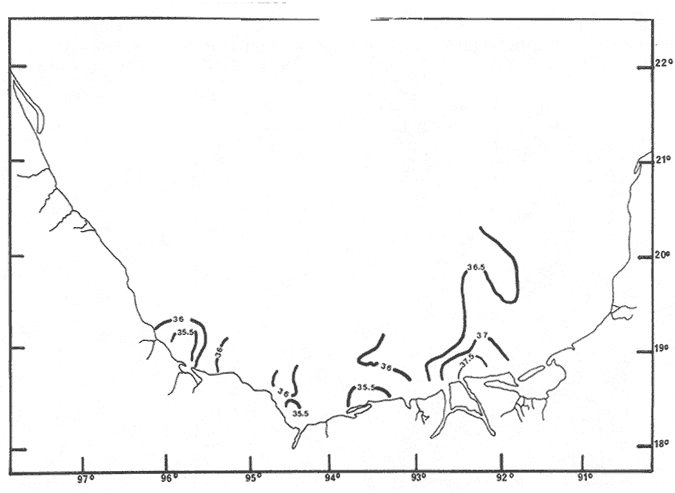 Figure 2. Subsuperficial isohalines (5m depth) in the Southern Gulf of Mexico (after Padilla et al, 1987).  Figure 3. Distribution of sediments in the Southern Gulf of Mexico (After Lecuanda and Ramos, 1995). METHODSThe samples used in this study were collectad during the IMECO cruise, in February of 1984, in the area south of latitude 210 North from Tuxpan to the Yucatan Shelf. Fifty six grab and gravity core samples, ranging in depth from 11 to 3200 m, were collected from the oceanographic vessel Justo Sierra of the National Autonomous University of México. However, only the 25 samples that contained at least 50 ostracodes were used in this study. Their location, method of collection and physical parameters are shown in Fig. 1 and Table 1. Subsamples of 20cc (core tops) and 45cc (grab samples) were dried, weighed, and wet sieved through a 63 micron screen. The dry residues were split into aliquots of 300 or more ostracodes using an Otto microsplitter; lf necessary two subsamples were used. A total of 150 species were determined and their absolute and relative abundances recorded. Using the species percentages, a Q-mode factor Analysis was performed using the sugbprogram "Factor" (Kim, 1977) of the Statistical Package for the Social Sciences (SPSS). The data matrix was formed by 93 species (Tables 2,3) (those species that had at least 1 % in one of the samples), and 25 samples (those with over 50 ostracodes). The Principal Factor with Iteration (PA2) and Varimax rotation methods of this subprogram were used. A six factor solution explaining over 70% of the data was employed. 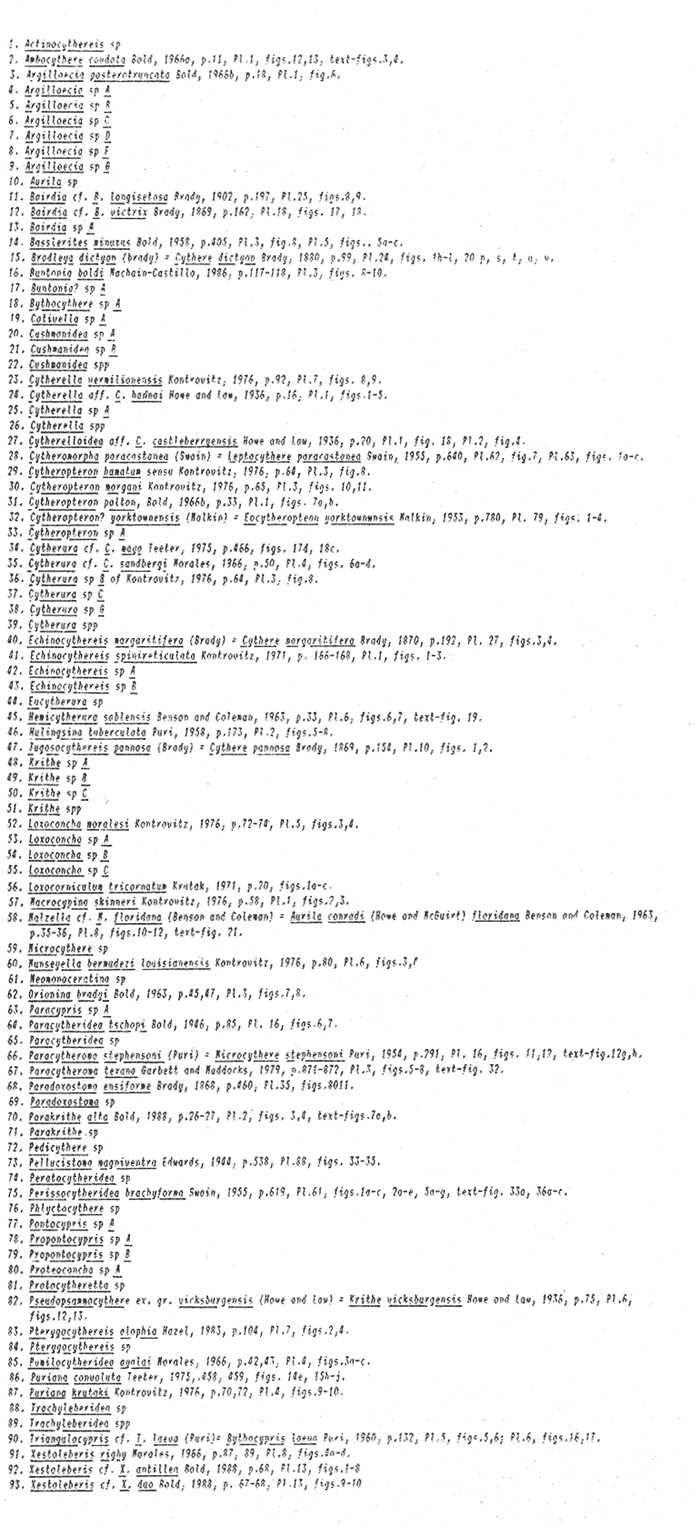 TABLE 2 FAUNAL REFERENCE LIST OF THE SPECIES USED IN THE FACTOR ANALYSIS 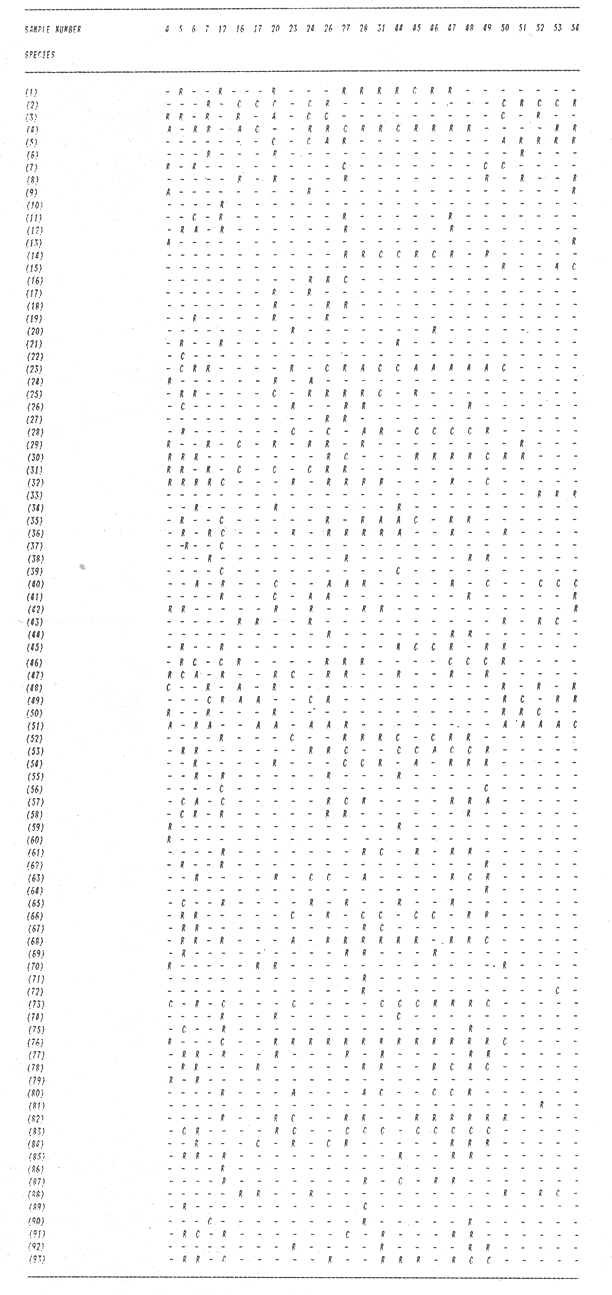 TABLE 3 DISTRIBUTION OF OSTRACODA IN THE SAMPLES USED IN THIS STUDY. SEE TABLE 2 FOR SPECIES NUMBER. OSTRACODE ASSEMBLAGESFactor analysis was used to delineate the geographic distribution of the faunal assemblages. Aerial distribution of the factor loadings is shown in figs. 4-10. Samples showing loadings greater than 0.3 are the ones considered to characterize the factors (Table 4). Fig. 4 shows that the assemblage delinated by Factor I is mainly distributed in the western side of Campeche Bay. The factor loadings show their highest values around stations 16 (279m) and 17 (618m). These samples contain a bathyal ostracod fauna consisting of species ofKrithe (up to 70%),Ambocythere cf.A. caudata, Aigilloeciaspp, Bradleya dictyon, Parakrithe spp,Pedicythere sp,Trachyleberidea sp, and possibily slumped shallower water species such as Cytheruraspp, Hulingsina tuberculata, Macrocyprina skinneri andParadoxostoma ensiforme (Plates 1, 2). Next higher values are at stations 5 (48.5m) and 4 (1387.0m). Station 5 contains an inner to middle shelf fauna and shares with statíons 16 and 17 species ofArgilloecia, Cytherura, H. tuberculata, Parodoxostoma ensiforme and Pterygocythereis alophia, which seem to be responsible for the high score on Factor I. Station 7 (360.9m) shows a lower score (0.45) than would be expected since it is located in the upper slope. This sample also contains high percentages of species ofKrithe, Argilloecia, A. cf. A. caudata, Echinocytherieis margaritifera, Parakrite spp as in samples 16 and 17, but it lacks B. dictyon,Pedicythere sp andTrachyleberidea sp. Stations 6, 12, 20 and 31 share the shallow water species and that seems to account for their clustering in this factor. Although Factor I was depicted with few stations, it can be said that it represents an upper bathyal fauna mixed-in with shelf material. A more detailed study, with a denser sampling network, is actually under way to better understand and delineate the distribution patterns in this area. The central Gulf fauna is represented by Factors V and VI (Figs 8, 9, Plate 1) It is characterized by species ofKrithe, up to 85%, and less abundantArgilloecia spp, Ambocytherecf.A. caudata, B. dyction, Echinocythereis spA and slumped shallower water species. The subdivision of this assemblage into an eastern group (Factor V) and western group (Factor VI) is due to the content of shallower water material. The contribution from the samples located to the south of the group delineated by Factor V is evidenced by the several species thery share (i.e. Argilloeciaspp,Cytherura sp B, Cytheropteron hamatum,etc) that is reflected by the low scores on this factor of samples 20 (0.246) and 17 (0.243). Sample 50 located west of the Campeche Escarpment, contains many species of the Campeche Shelf and shows a high taxonomic similarity with samples 49 and 27 located on the outer Campeche Shelf, which accounts, for its presence with a medium score (0.44) on factor IV.  Figure 4. Factor I loadings over 0.3. See Fig. 1 for station. Factors II, III and IV comprise the samples located in the transitional zone between the Campeche Platform and the terrigenous province of the Gulf of Mexico (Figs 5-7, Plates 3-5). The ostracode fauna in this region is the most abundant and diverse of the studied area. It is characterized by Cytherella vermilionensis, Loxoconcha moralesi, L. sp A, L. sp. B, Proteoconcha sp A, Cytheromorpha paracastanea,Pterygocythereis alophia,Pellucistoma magniventra, andParacytheroma stephensoni(Plate 3). The groupings delineated by the three factors share about 50% of the species, but some differences are found among them. The eastern part coincides with the high loadings of Factor II (Fig. 5). This assemblage contains the highest abundandces of C. vermilionesis (up to 30%),Proteoconcha sp. A, L. moralesi, C. paracastanea, P. alophia, P. stephensoni and lower abundances ofBasslerites minutus, Cytheruraspp, andPhlyctocythere sp. This fauna lives on or in carbonato sediments and is influenced by the high salinity (36.5-37.0%) waters of Campeche Bay. 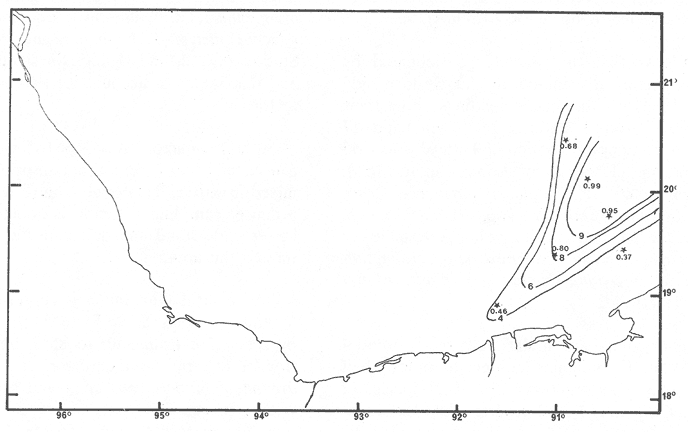 Figure 5. Factor II loadings over 0.3. See Fig 1 for station numbers. 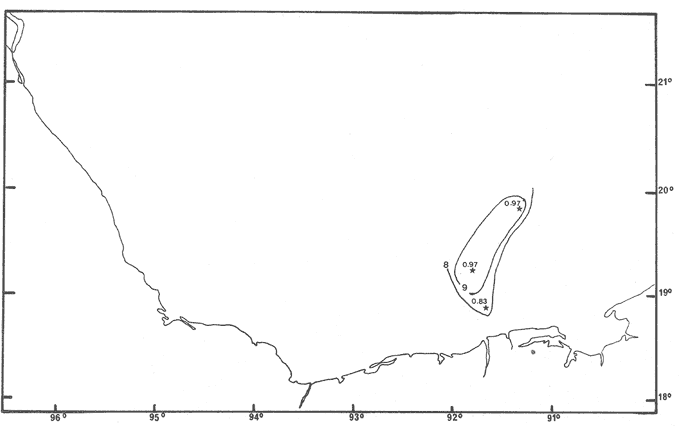 Figure 6. Factor III loadings over 0.3. See Fig. 1 for station numbers. Factor IV (Fig. 7) has a taxonomic composition very similar to Factor II, but it has lower abundances ofC. vermilionesis, Pstephensoni, L. moralesi, C. paracastanea, P. alophia, and higher abundances ofPhlyctocytheresp, Cytherura spp andXestoleberis spp, reflecting a greater influence of Terminos Lagoon in the shallower samples (44, 45, 27), whereas in sample 49, specimens of Puriana spp,Loxocorniculum tricomatum, Orionina bradyi and Bairdids are present indicating a higher similarity to the Yucatan Shelf fauna (Plate 4). However, this sample seems to cluster with Factor III due to a lower abundance of C. vermilionensis and higher abundances ofArgilloecia spp,Baislérites minutus, Cytheropteron morgani andCytherura d. C. sandbergi. 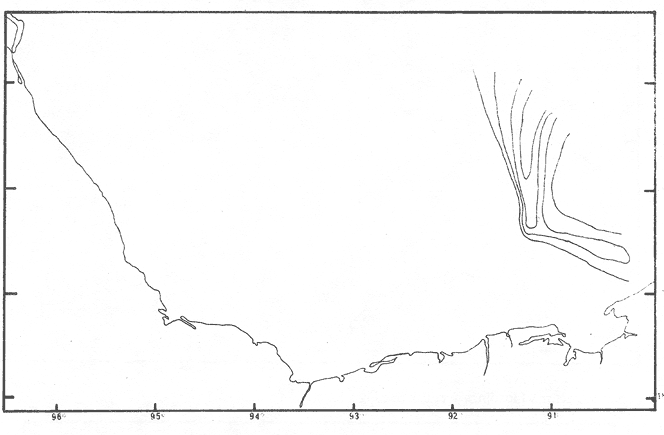 Figure 7. Factor IV loadings over 0.3. See Fig 1 for station numbers. 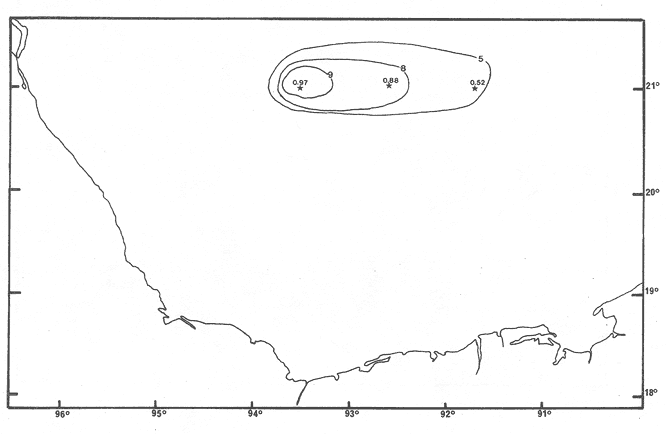 Figure 8. Factor V loadings over 0.3. See Fig. 1 for station numbers. Factor III (Plate 5, Fig. 6) is somewhat different. It comprises the three westernmost and, except for sample 23, the deepest samples of this area. It is dominated byKrithe spp, Laxoconcha sp. A, Proteoconcha sp. A, Echinocythereis spinireticulata, Cytherella sp A, P. magniventra, Paradoxostoma ensiforme, E. margaritifera, Paracypris sp A and P. stephensoni. It contains some species only found here such as A. cf. A. caudata, Cytherellaaff.C. hannai, Argilloecia posterotruncata,Cytheropteron palton, E. spinireticulata and Krithe spp which are characteristic of deeper waters.  Figure 9. Factor VI loadings over 0.3. See Fig 1 for station numbers.  Figure 10. Arcal distribution of the ostracode assemblages outlined by factor analysis. Sample 23 also shows high scores on Factor II with which it shares several species that are not present in the other samples of Factor III (i,e., L. moralesi, L.spA, Proteoconcha sp A, C. vermilionensis, P. alophia, etc). This relationship could be due to bathymetry since all of these samples are located on the inner to middle shelf. However it could also represent the influence of the higher salinity Campeche waters (also influencing the inner and middle shelves). 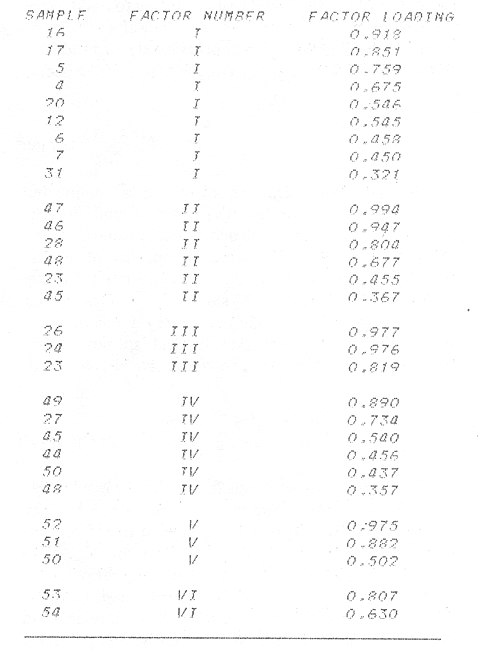 TABLE 4 VARIMAX FACTOR LOADINGS DISCUSSIONThe distribution patterns of the ostracodes do not reflect only the bathymetry in the Southern Gulf of Mexico Shelf. In the western zone, assemblages seem to be a result of slumping of shallower material that mixes with deeper populations. In the Campeche Sound, there is faunal mixing in the inner and middle shelves. This homogenization could have resulted from local circulation patterns; however, East-West patterns can be depicted in this area. This gradient may reflect the transition in environments found in the area between the Eastern and Western Campeche Bay. As mentioned before, the eastern side is characterized by clear waters, carbonate sediments, low organic matter content and high salinities, whereas to the west of Terminos Lagoon waters are turbid, the sediments terrigenous with high organic content, and with lower salinities. This transition has been found to be a local barrier for the distribution of many organisms (Sánchez-Gil et al, 1981; Yáñez-Arancibia and Sánchez-Gil, 1986). The ostracode fauna also seems to respond to the transition as it has a characteristic fauna in this zone. On the outer shelf and deeper environments, this fauna is replaced by more typical outer shelf to upper bathyal assemblage (samples 24 and 26). Although these samples share species (probably slumped) with the shallower areas of the Terminos Lagoon System as indicated by their clustering in Factor III with sample 23. Another interesting point in the ostracode distribution of this area is exemplified by sample 23. As it is observed in Fig.5, the map distribution of the Factor II loadings show how the center of dístribution of this assemblage is located in samples 46 and 47 and dissipates towards deeper (48) and shallower (45) stations. To the west, this factor can be picked out up to station 23 (longitude 92º37.8'). The geographic distribution of this factor seems to be correlated with the high salinity waters that have been reported by Lizarraga et al(1984) on the Yucatan Shelf, and that according to Padillaet al (1987) sink west of Terminos Lagoon and intersect the inner to middle shelf up lo approximately longitude 93º west. The common factor in all of these samples seems to be their high populations ofC. vermilionensis. Therefore, abundant populations of this species could be indicative of this water mass and its average distribution through time. More studies about the ecological preferences of this species and a denser sampling network are needed to corroborate this hypothesis. ConclusionesSix principal ostracode assemblages, delineated by Q-Mode Factor Analysis, are found in the Southem Gulf of Mexico: Two Central Gulf assemblages are dominated by species ofKrithe; the difference between them is accounted for the amount and origin of slumped, shallow water material. A Western Campeche Bay fauna consists of a mixture of shelf and bathyal species. Three transitional assemblages are found around Terminos Lagoon that mark, form East to West, the transition between the higher salinity-carbonate province and the lower salinity, terrigenous province of the Southern. Gulf of Mexico. The distribution of Ostracoda seem to be affected by depth, type of sediment and fluvial discharge. A closer sampling network is needed to better deliniate these distribution patterns. AgradecimientosThe present research was funded by the Instituto de Ciencias de Mar Limnología of the U.N.A.M. The author wishes to express her gratitude to J. Carranza Frazer (chairman of the IMCyL) an A. Ayala Castañares (former chairman) for their support and facilities to conduct this project. Sincere thanks are also expressed to J. Hazel and T. Cronin for their review and useful comments, to A. Molina for his help in collecting the samples, the computer programs and reading this manuscript, and to R. Gío-Argáez for his suggestions to this manuscript. A.M. Pérez-Guzmán collected the samples; A. Pineda washed the sediments; Y. Hornelas took the Scanning electron microphotographs and C. Melo printed them; L. Pérez-Cruz and R. Trápaga helped with the drafting and typing. Appreciation is extended to all of them. LITERATURABENSON, R.H. and G.L COLEMAN III, Univ. Kansas Paleont. Contr. Arthropoda, Art.Recent marine ostracodes from eastern Gulf of Mexico.1963.1-52.2: BOLD, W.A. van den,Contributions to the study of Ostracoda with special reference to the Tertiary and Cretaceous mierofauna of the Caribbean Region.Diss. Univ. Ultrecht, Debussy, Amsterdam: 1946.1-167. BOLD, W.A. van den, Micropaleontology, Ostradoca of the Brasso Formation of Trinidad.1958.71-74.4(1): BOLD, W.A. van den, Jour. Paleontology, The ostracode genus Orionina and its species.1963.33-50. 37. BOLD, W.A. van den, Ann. Mag. Nat. Hist. ser.13,New species of the genus Ambocythere.1966a.1-18.8(1): BOLD, W.A. van den, Vehr. Kon. Nederl. Akad. Wetensch. ser 1, Miocene and Pliocene Ostracoda of northeastern Venezuela.1966b.1-43.23: BOLD, W.A. van den, Bull. Amer. Paleont.,Neogene Paleontology in the northern Dominican Republic 7. The Subelass Ostracoda (Arthropoda: Crustacea).1988.1 -105. 94(329): BRADY, G.S., Ostracoda. In: De Folin and Perier, Les Fonds de la Mer.Paris.1867-1872. BRADY, G.S., , Rep. Voyage H.M.S. Challenger, Zool.Report on the Ostracoda dredged by the H. M. S. Challenger during the years 1873-1876.1880.10-184.1: BRADY, G.S., Zool. Soc. London, Trans., On new or imperfectly known species of Ostradoda mostly from collections in the Zoological Museum of Copenhagen. 1902.179-210.16 (4): EDWARDS, R.E, Jour. Paleont.,Ostracoda from the Duplin Marl (Upper Miocene) of North Carolina.1944.505-528. 18: GARBETT, E.E. and R.F. MADDOCKS, Jour. Paleont.,Zoogeography of Holocene Cytheracean ostracodes in the baya of Texas.1979.841-919.53(4): GREINER, G.O.G., Environmental factors controlling the distribution of Recent benthonic Forminifera. Breviora,1974.1-35. 420: HAZEL, J.E., Age and correlation of the Yorktown (Pliocene) and Croatan (Pliocene and Pleistocene) Formations at the Lee Creck Mine. Smithsonian Cont. to Paleobiol,1983.80-199.53: HOWE, H.V. AND J. LAW, Dept. Cons. La Geol. Surv. Bull.,Louisiana Vicksburg Oligocene Ostracoda.1936.1-92.7: KIM, J.O., Statistical Package for the Social Science.Factor analysis,SPPS, In. Nie, N.H., C.H. Hull, J.G. Jenkins, Y, Steinbrenner and D.H.Bent (Eds).McGraw Hill, New York.1977.p.468-514 KONTROVITZ. M., A Tulane Stud. Geol Paleont., new Holocene species of Echinocythereis (Ostracoda).1971.166-168.8(3): KONTROVITZ.M, Ostracoda from the Louisiana Continental Shelf. Tulane. Sud Geol. Paleontol.,1976.49-100.12(2): KRUTAK, P.R., Micropaleontoloy, The Recent Ostracoda of Laguna Mandinga, Veracruz, Mexico.1971.1-30.17: KRUTAK, P.R-, West Indies Lab. Spec. Fairleigh Dickinson University, St. Croix, U.S. Standing crops of modern ostracods in lagoonal and reefal environments, Veracruz, Mexico.Publ.no.6,Virgin Islands.1974.11-14. KRUTAK, P.P., Reefs and related carbonates, Ecology and Sedimentology. Amer. Assoc. Pet. Geol. Stud. in Geol. Change in ostracod standing crop, Laguna Mandinga, Veracruz, Mexico. In: Fronst, S.H.(Ed.). 1977.209- 218.4: KRUTAK, P.R., Micropaleontology, Modern ostracodes of the Veracruz-Anton Lizardo Reefs, Mexico.1982.258-288.28: KRUTAK, P.R. and S.E.RICKLES, Equilibrium in modem coral reefs, Westem Gulf of Mexico-Role of ecologyand ostracod microfauna. Gulf Coast, Assoc. Geol. Socs. Trans.,1979.163-274.29: KRUTAK, P.R., S.E. RICKLES and R. GIO-ARGAEZ, An. Inst Cienc del Mar y Limnol. Modern ostracode species diversity, dominance and biofacies patterns, Veracruz-Anton Lizardo Reefs, Mexico.Univ. Nal Autón. México, 1980.181-198.7. LECUANDA, R. and F. RAMOS, Informe Técnico No.2, Inst. Cienc. del Mar y Limnol.Distribución de sedimentos en el sur del Golfo de México.Univ. Nal. Autón, México.1985. LIZARRAGA-PARTIDA, M.L, BOTELLO, S. LICEA-DURAN, C. FLORES-COTO, LA. SOTO and A. YÁÑEZ-ARANCIBIA, Informe de la campaña oceanográfica "PROGMEX" Inst. Cienc. del Mar y Limnol. Univ. Nal. Autón. México,1984.148p. MACHAIN-CASTILLO, M. L., Encanto and Concepcion Biofacies. Rey Soc. Mex. Hist. Nat, Pliocene Ostacoda of Southeastern Mexico. Part I,1986.81-146.38: MADDOCKS, P, F., Biota of the West Flower Garden Bank. Flower Garden Ocean Res. Center. Gulf publishing Co.,Ostracodes In: Bright, T.S., and L.N. Pequegnat (Eds.) Houston, Texas:1974.199-229. MALKIN, D. S., Jour. Paleont., Biostratigraphic study of Miocene Ostracoda of New Jersey, Maryland and Virginia.1953.761-799.27 (6): MORALES, G.A., Ecology, distribution and taxonomy of Recent Ostacoda of the Laguna de Términos, Campeche, México. [Bol. Inst. Geol. Univ. Nal. Autón. México, 81]:1966.1-103. NOWLIN, W.D. Jr., Contribution on the Physical Oceanography of the Gulf of Mexico. Texas A & M University, Oceanography Studies 2. Gulf Publishing Co,Winter circulation patterns and property distributions. In: Capurro, L.R. and J. L. Reid (Eds). Houston, Texas.1972. PADILLA, A.R, M.A. ALATORRE, F. RUIZ and S.P.R. CZITRON, Union Geof. Mex. A.C. Runión Anual 1986. Morelia, Michoacán: Observaciones recientes de la estructura termohalina en el sur del Golfo de México.1987. 434- 440. PALACIOS-FEST, M.R., F.R. GIO-ARGAEZ y P.R. KRUTAK, An. Inst. Cienc. del Mar y Linmol.,Los ostrácodos recientes del Caribe Mexicano y su significación faunística. Univ. Nal. Autón. México, 1983.195-208.10 (1): PURI, H.S., Fla. Geol. Surv. Bull.,Contribution to the study of the Miocene of Florida Panhandle. 1954.1-345.36. PURI, H.S., Ostracode genus Cushmanidea. Gulf Coast. Assoc. Geol. Soc. Trans.,1958.171-181.8: PURI, H.S., Recent ostracoda from the west Coast of Florida. Gul. Coast. Assoc. Geol. Soc. Trans.,1960.107-149.10. SÁNCHEZ-GIL, P., A. YÁÑEZ ARANCIBIA and F. AMEZCUALINARES, An Inst. Cienc. del Mar y Limnol. Diversidad, distribución y abundancia de las especies y poblaciones de peces demersales de la Sonda de Campeche (Verano, 1978). Univ. Nal Autón. México1981.209-240.8(1): SANDBERG, P.A., Ostracodes as ecological and paleocological indicators. Pubblicazione della Stazione Zoologica di Napoli 33 Suppl Notes on some Tertiary and Recent brackish-water Ostracods, In: Puri, H.S. (Ed.). 1964.496-514. SWAIN, F.M., Jour. Paleont., Ostracoda of San Antonio Bay, Texas. 1955.561-646.29: TETER, J.W., Belize Shelf carbonate sediments, clastic sediments and ecology. Amer. Assoc. Pet. Geol Studies in Geol., Distribution of Holocene Ostracoda from Belize. In: Wantland K.F. and Pusey, W.C.III, (Eds.).1975.400-499.2: YÁÑEZ-ARANCIBIA, A. and P. SÁNCHEZ-GIL,An. Inst Ciencias del Mar y Limnol., Los peces demersales de la plataforma Continental de Sur del Golfo de México. Caracterización ambiental, ecología y evaluación de las especies, poblaciones y comunidades. Univ. Nal. Autón. México,1986.1-230.9: LAMINAS
 Figura 11. Plate 1. 1) Krithe sp A, lefl valve, sample 7, X67.7; 2)Parakrithe sp Z right valve, sample 17, X93.3; 3) Argilloecia sp A, left valve, sample 16, XI 15; 4) Argilloecia sp G, left valve, sample 54, X107.1; 5) Ambocythere caudata Bold, left valve, sample, 52, X72.9; 6) Bradleya dictyon (Brady) right valve, sample 53. X43.4. 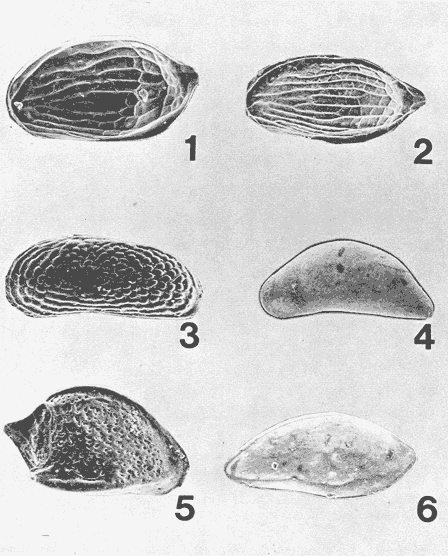 Figura 12. Plate 11. 1) Cytheura cf. C sandbergi Morales, left valve, sample 31, X130.9; 2) Cytheura sp. C. left valve, sample 49, X114.9;3) Hulingsina tuberculata Puri, left valve, sample 12, X79.0; 4)Macrocyprina skineri Kontrovitz, left valve, sample 12, X41.0; 5) Cytheropteron hamatum sensu Kontrovitz, right valve, sample 20, X1 14.5; 6)Paradoxostoma ensiforme Brady, left valve, sample 6, X78.5.  Figura 13. Plate 111. 1) Cytherella vermilionensis Kontrovitz, left valve, sample 23, X100.1; 2) Proteconcha sp. A,left valve, sample 28, X92. 1; 3) Loxoconcha moralesi Kontrovitz, left valve, sample 44, X72.7; 4) Loxoconcha sp A, left valve, sample 48, Xl 14.9; 5) Loxoconcha sp B, left valve, sample 26, X84.2; 6) Pellucistoma magniventra Edwards, left valve, sample 44, X76.5.  Figura 14. Plate IV. 1) Basslerites minutus Bold, right valve, sample 46, X108; 2) Phlyctocythere sp, right valve, sample 28, X100.9;3) Bairdia cf. B. longisetosa Brady, left valve, sample 12, X51 3; 4) Loxocorniculum tricomatum Krutak, left valve, sample 49, X1 16.8; 5) Xestoleberis rigby Morales, left valve, sample 27, X 136.2; 6) Xestoleberis cf. X. duo Bold, left valve, sample 49, X72.0.  Figura 15. Plate V. 1) Echinocythereis spinireticulata Kontrovitz, right valve, sample 24, X52.9; 2) Cytherella aff. C. hannai, left valve, sample 24, X67.3; 3) Paracypris sp. A, left valve, sample 26, X38.9; 4) Cytheropteron palton Bold, left valve, sample 26, X78.1; 5) Paracytheroma stephensoni (Puri), left valve, sample 46, X94.0.
|

